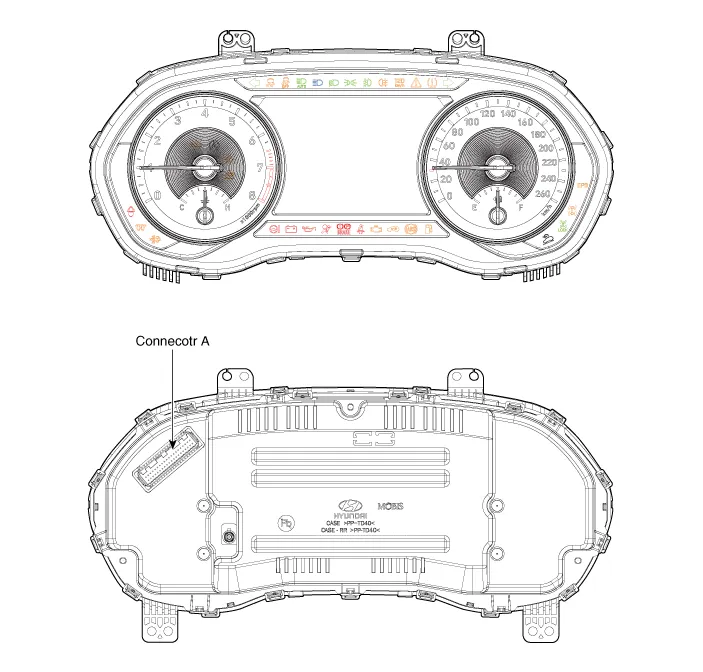Hyundai Palisade (LX2): Indicators And Gauges / Components and components location
| Components |


|
No |
Connector A |
No |
Connector B |
|
1 |
Ground |
21 |
Trip switch (-) |
|
2 |
Illumination (-) |
22 |
Trip switch 1 (+) |
|
3 |
Rheostat switch (Down)_Input |
23 |
Trip switch 2 (+) |
|
4 |
Rheostat switch (Up)_Input |
24 |
Active ECO_input switch/ R switch(M/T)_input |
|
5 |
Dentent |
25 |
Driver mode switch/ N switch(M/T)_input |
|
6 |
- |
26 |
Speaker1 (+)_Output |
|
7 |
- |
27 |
Speaker1 (-)_Output |
|
8 |
- |
28 |
- |
|
9 |
- |
29 |
B-CAN (Low) |
|
10 |
- |
30 |
B-CAN (High) |
|
11 |
- |
31 |
Engine Run State_Output |
|
12 |
Vehicle speed_Output |
32 |
C-CAN (High) |
|
13 |
Alternator_Input |
33 |
C-CAN (Low) |
|
14 |
Fuel sender (+)_Input |
34 |
Temperature_Input |
|
15 |
- |
35 |
- |
|
16 |
Fuel sender (-)_Input |
36 |
Steering wheel heater indicator |
|
17 |
Water separate_Input |
37 |
Ground |
|
18 |
Airbag (+)_Input |
38 |
- |
|
19 |
Oil press switch (-)_Input |
39 |
IGN 1 |
|
20 |
- |
40 |
Battery (+) |
Description Communication Network Diagram Abbreviation Explanation IBU Interated Body Control Unit DDM Driver Door Module PTGM Power Tail Gate Module ICU Interated Control Unit ECU Engine Control Unit CLU Cluster MDPS Moter Driven Power Steering SVM Sorround View Monitor ACU Airbag Control Unit VDC Vehicle Dynamic Control SCC Smart Cruise Control LKA Lane Keeping Assist BCW Blind-Spot Collision Warning SAS Steering Angle Sensor HUD Head up Display TCU Transmission Control Unit FR DATC Dual Automatic Temp Control 4WD Four Wheel Drive F/PUMP Fuel Pump Control Module POCS Passenger Occupant Classification System IMS Integrated Memory System AMP Amplifier AVN Head Unit (Audio / AVN) HUD Head Up Display RR CAMERA Rrar View Camera FR CON Front Console Switch EOP Electric Oil Pump SBW Shift BY Wire W/CHAR Wireless Power Chager FR M/LP Front Mood Lamp 3ND FOLD 3ND Seat Folding Control Unit AUDIO Audio unit KEY BOARD Center Fascia Keyboard
Other information:
Hyundai Palisade (LX2) 2020-2025 Service Manual: Wireless Charging Lamp
Components and positions Components Repair procedures Removal Handling wireless charging system parts by wet hands may cause electric shock.
Hyundai Palisade (LX2) 2020-2025 Service Manual: Repair procedures
Inspection 1. Turn the ignition switch ON. 2. Manually operate the control switch and measure the voltage of the blower motor. 3. Select the control switch to raise the voltage until it reaches high speed.
Categories
- Manuals Home
- Hyundai Palisade Owners Manual
- Hyundai Palisade Service Manual
- Resetting the Driver's Seat Memory System
- Blind-spot View Monitor system
- Emergency Precautions
- New on site
- Most important about car
